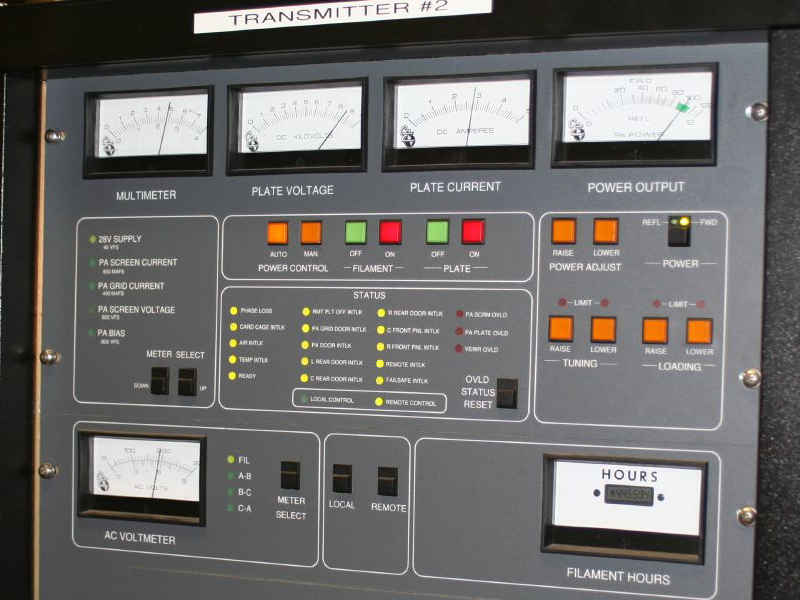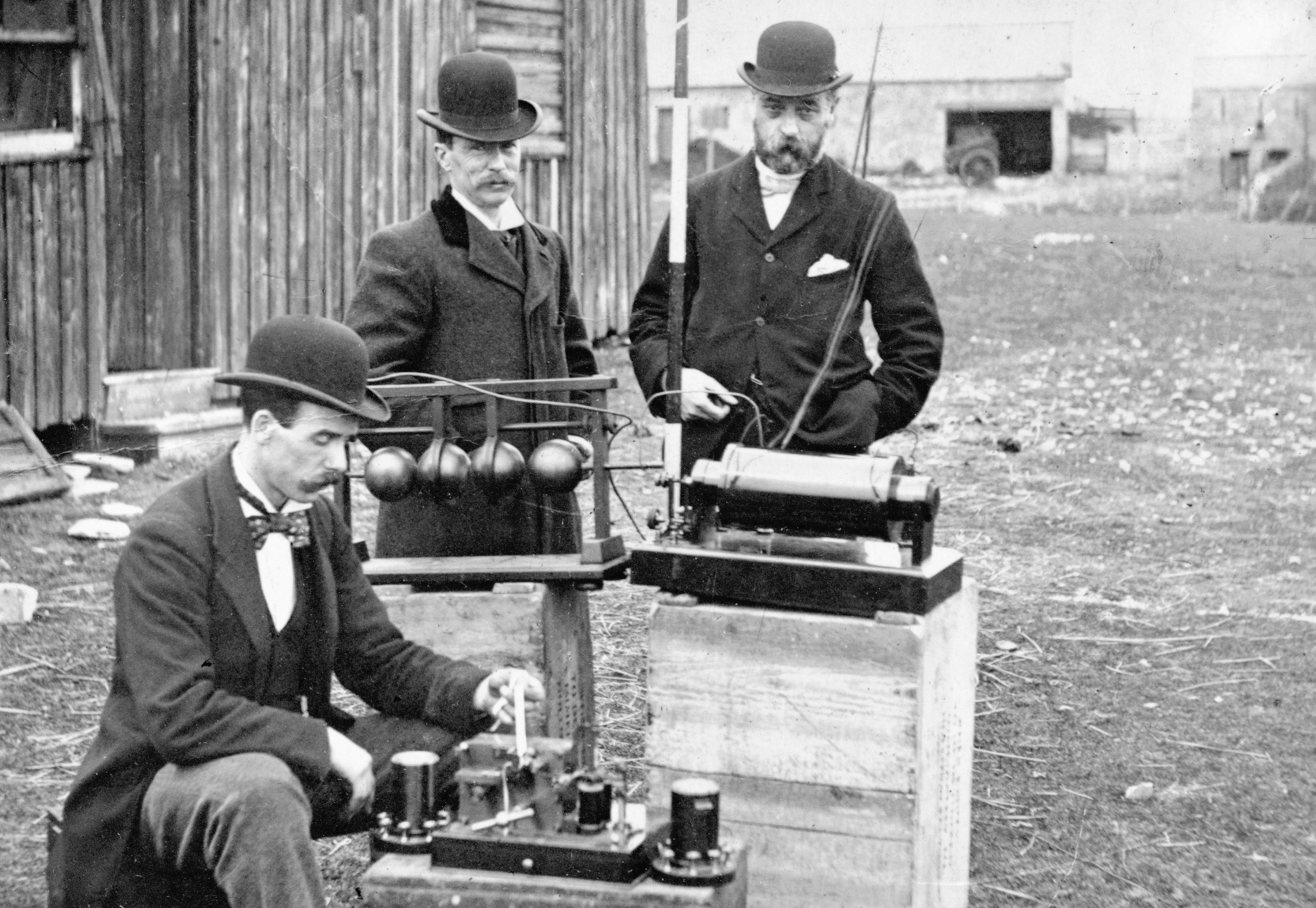|
Radiotelegraph
Wireless telegraphy or radiotelegraphy is the transmission of text messages by radio waves, analogous to electrical telegraphy using electrical cable, cables. Before about 1910, the term ''wireless telegraphy'' was also used for other experimental technologies for transmitting telegraph signals without wires. In radiotelegraphy, information is transmitted by pulses of radio waves of two different lengths called "dots" and "dashes", which spell out text messages, usually in Morse code. In a manual system, the sending operator taps on a switch called a telegraph key which turns the transmitter on and off, producing the pulses of radio waves. At the radio receiver, receiver the pulses are audible in the receiver's speaker as beeps, which are translated back to text by an operator who knows Morse code. Radiotelegraphy was the first means of radio communication. The first practical radio transmitters and radio receiver, receivers invented in 1894–1895 by Guglielmo Marconi used radi ... [...More Info...] [...Related Items...] OR: [Wikipedia] [Google] [Baidu] |
Morse Code
Morse code is a telecommunications method which Character encoding, encodes Written language, text characters as standardized sequences of two different signal durations, called ''dots'' and ''dashes'', or ''dits'' and ''dahs''. Morse code is named after Samuel Morse, one of the early developers of the system adopted for electrical telegraphy. International Morse code encodes the 26 ISO basic Latin alphabet, basic Latin letters to , one Diacritic, accented Latin letter (), the Arabic numerals, and a small set of punctuation and procedural signals (Prosigns for Morse code, prosigns). There is no distinction between upper and lower case letters. Each Morse code symbol is formed by a sequence of ''dits'' and ''dahs''. The ''dit'' duration can vary for signal clarity and operator skill, but for any one message, once the rhythm is established, a beat (music), half-beat is the basic unit of time measurement in Morse code. The duration of a ''dah'' is three times the duration ... [...More Info...] [...Related Items...] OR: [Wikipedia] [Google] [Baidu] |
Spark-gap Transmitter
A spark-gap transmitter is an obsolete type of transmitter, radio transmitter which generates radio waves by means of an electric spark."Radio Transmitters, Early" in Spark-gap transmitters were the first type of radio transmitter, and were the main type used during the wireless telegraphy or "spark" era, the first three decades of radio, from 1887 to the end of World War I. German physicist Heinrich Hertz built the first experimental spark-gap transmitters in 1887, with which he proved the existence of radio waves and studied their properties. A fundamental limitation of spark-gap transmitters is that they generate a series of brief transient pulses of radio waves called Damped wave (radio transmission), damped waves; they are unable to produce the continuous waves used to carry audio signal, audio (sound) in modern AM broadcasting, AM or FM broadcasting, FM radio transmission. So spark-gap transmitters could not transmit audio, and instead transmitted information by radiotelegra ... [...More Info...] [...Related Items...] OR: [Wikipedia] [Google] [Baidu] |
Radio Communication
Radio is the technology of telecommunication, communicating using radio waves. Radio waves are electromagnetic waves of frequency between 3 hertz (Hz) and 300 gigahertz (GHz). They are generated by an electronic device called a transmitter connected to an antenna (radio), antenna which radiates the waves. They can be received by other antennas connected to a radio receiver; this is the fundamental principle of radio communication. In addition to communication, radio is used for radar, radio navigation, radio control, remote control, remote sensing, and other applications. In radio communication, used in radio and television broadcasting, cell phones, two-way radios, wireless networking, and satellite communication, among numerous other uses, radio waves are used to carry information across space from a transmitter to a receiver, by Modulation, modulating the radio signal (impressing an information signal on the radio wave by varying some aspect of the wave) in the tran ... [...More Info...] [...Related Items...] OR: [Wikipedia] [Google] [Baidu] |
Continuous Wave
A continuous wave or continuous waveform (CW) is an electromagnetic wave of constant amplitude and frequency, typically a sine wave, that for mathematical analysis is considered to be of infinite duration. It may refer to e.g. a laser or particle accelerator having a continuous output, as opposed to a pulsed output. By extension, the term ''continuous wave'' also refers to an early method of radio transmission in which a sinusoidal carrier wave is switched on and off. This is more precisely called interrupted continuous wave (ICW). Information is carried in the varying duration of the on and off periods of the signal, for example by Morse code in early radio. In early wireless telegraphy radio transmission, CW waves were also known as "undamped waves", to distinguish this method from damped wave signals produced by earlier ''spark gap'' type transmitters. Radio Transmissions before CW Very early radio transmitters used a spark gap to produce radio-frequency oscillations i ... [...More Info...] [...Related Items...] OR: [Wikipedia] [Google] [Baidu] |
Transmitter
In electronics and telecommunications, a radio transmitter or just transmitter (often abbreviated as XMTR or TX in technical documents) is an electronic device which produces radio waves with an antenna (radio), antenna with the purpose of signal transmission to a radio receiver. The transmitter itself generates a radio frequency alternating current, which is applied to the Antenna (radio), antenna. When excited by this alternating current, the antenna Electromagnetic radiation, radiates radio waves. Transmitters are necessary component parts of all electronic devices that communicate by radio communication, radio, such as radio broadcasting, radio (audio) and television broadcasting stations, cell phones, walkie-talkies, Wireless LAN, wireless computer networks, Bluetooth enabled devices, garage door openers, two-way radios in aircraft, ships, spacecraft, radar sets and navigational beacons. The term ''transmitter'' is usually limited to equipment that generates radio waves fo ... [...More Info...] [...Related Items...] OR: [Wikipedia] [Google] [Baidu] |
Beat Frequency Oscillator
In a radio receiver, a beat frequency oscillator or BFO is a dedicated electronic oscillator, oscillator used to create an audio frequency signal from Morse code radiotelegraphy (Continuous wave, CW) transmissions to make them audible. The signal from the BFO is mixed with the received signal to create a heterodyne or Beat (acoustics), beat frequency which is heard as a tone in the speaker. BFOs are also used to demodulate single-sideband modulation, single-sideband (SSB) signals, making them intelligible, by essentially restoring the carrier wave, carrier that was suppressed at the transmitter. BFOs are sometimes included in communications receivers designed for short wave listeners; they are almost always found in communication receivers for amateur radio, which often receive CW and SSB signals.Larry Wolfgang, Charles Hutchinson (ed), ''The ARRL Handbook for Radio Amateurs Sixty Eighth Edition'', ARRL, -9, pages 12-29,12-30 The beat frequency oscillator was invented in 1901 by C ... [...More Info...] [...Related Items...] OR: [Wikipedia] [Google] [Baidu] |
Telegram
Telegraphy is the long-distance transmission of messages where the sender uses symbolic codes, known to the recipient, rather than a physical exchange of an object bearing the message. Thus flag semaphore is a method of telegraphy, whereas pigeon post is not. Ancient signalling systems, although sometimes quite extensive and sophisticated as in China, were generally not capable of transmitting arbitrary text messages. Possible messages were fixed and predetermined, so such systems are thus not true telegraphs. The earliest true telegraph put into widespread use was the Chappe telegraph, an optical telegraph invented by Claude Chappe in the late 18th century. The system was used extensively in France, and European nations occupied by France, during the Napoleonic era. The electric telegraph started to replace the optical telegraph in the mid-19th century. It was first taken up in Britain in the form of the Cooke and Wheatstone telegraph, initially used mostly as an aid to railw ... [...More Info...] [...Related Items...] OR: [Wikipedia] [Google] [Baidu] |
Radiotelephony
A radiotelephone (or radiophone), abbreviated RT, is a radio communication system for conducting a conversation; radiotelephony means telephony by radio. It is in contrast to ''radiotelegraphy'', which is radio transmission of telegrams (messages), or ''television'', transmission of moving pictures and sound. The term is related to radio broadcasting, which transmit audio one way to listeners. Radiotelephony refers specifically to two-way radio systems for bidirectional person-to-person voice communication between separated users, such as CB radio or marine radio. In spite of the name, radiotelephony systems are not necessarily connected to or have anything to do with the telephone network, and in some radio services, including GMRS, interconnection is prohibited. Design Mode of emission The word ''phone'' has a long precedent beginning with early US wired voice systems. The term means ''voice'' as opposed to telegraph or Morse code. This would include systems fitting ... [...More Info...] [...Related Items...] OR: [Wikipedia] [Google] [Baidu] |
Guglielmo Marconi
Guglielmo Giovanni Maria Marconi, 1st Marquess of Marconi ( ; ; 25 April 1874 – 20 July 1937) was an Italian electrical engineer, inventor, and politician known for his creation of a practical radio wave-based Wireless telegraphy, wireless telegraph system. This led to Marconi being credited as the inventor of radio and sharing the 1909 Nobel Prize in Physics with Karl Ferdinand Braun "in recognition of their contributions to the development of wireless telegraphy". His work laid the foundation for the development of radio, television, and all modern wireless communication systems. Marconi was also an entrepreneur and businessman who founded the Wireless Telegraph & Signal Company (which became the Marconi Company) in the United Kingdom of Great Britain and Ireland, United Kingdom in 1897. In 1929, Marconi was ennobled as a marchese, marquess (''marchese'') by Victor Emmanuel III. In 1931, he set up Vatican Radio for Pope Pius XI. Biography Early years Guglielmo Giovanni Mar ... [...More Info...] [...Related Items...] OR: [Wikipedia] [Google] [Baidu] |
Types Of Radio Emissions
The International Telecommunication Union uses an internationally agreed system for classifying radio frequency signals. Each type of radio emission is classified according to its Bandwidth (signal processing), bandwidth, method of modulation, nature of the modulating signal, and type of information transmitted on the carrier signal. It is based on characteristics of the ''signal'', not on the transmitter used. An emission designation is of the form ''BBBB 123 45'', where ''BBBB'' is the bandwidth of the signal, ''1'' is a letter indicating the type of modulation used of the main carrier (not including any subcarriers which is why FM stereo is F8E and not D8E), ''2'' is a digit representing the type of modulating signal again of the main carrier, ''3'' is a letter corresponding to the type of information transmitted, ''4'' is a letter indicating the practical details of the transmitted information, and ''5'' is a letter that represents the method of multiplexing. The ''4'' and ' ... [...More Info...] [...Related Items...] OR: [Wikipedia] [Google] [Baidu] |
Modulation
Signal modulation is the process of varying one or more properties of a periodic waveform in electronics and telecommunication for the purpose of transmitting information. The process encodes information in form of the modulation or message signal onto a carrier signal to be transmitted. For example, the message signal might be an audio signal representing sound from a microphone, a video signal representing moving images from a video camera, or a digital signal representing a sequence of binary digits, a bitstream from a computer. This carrier wave usually has a much higher frequency than the message signal does. This is because it is impractical to transmit signals with low frequencies. Generally, receiving a radio wave requires a radio antenna with a length that is one-fourth of the wavelength of the transmitted wave. For low frequency radio waves, wavelength is on the scale of kilometers and building such a large antenna is not practical. Another purpose of modulation ... [...More Info...] [...Related Items...] OR: [Wikipedia] [Google] [Baidu] |







